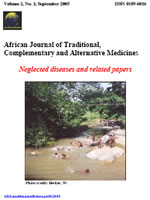
|
African Journal of Traditional, Complementary and Alternative Medicines
African Ethnomedicines Network
ISSN: 0189-6016
Vol. 12, No. 2, 2015, pp. 6-11
|
 Bioline Code: tc15020
Bioline Code: tc15020
Full paper language: English
Document type: Research Article
Document available free of charge
|
|
|
African Journal of Traditional, Complementary and Alternative Medicines, Vol. 12, No. 2, 2015, pp. 6-11
| en |
CHINESE HERBAL MEDICINE ALLEVIATING HYPERANDROGENISM OF PCOS RATS THROUGH REGULATING PPARG1 AND HDAC3 EXPRESSION IN THE OVARIES
Gu, Ying-Er; Wang, Fang-Fang; Yang, Dong-Xia; Zhou, Jue; Ye, Ying-Hui; Zhu, Yu-Hang; Jiang, Dan & Qu, Fan
Abstract
Background: Polycystic ovarian syndrome (PCOS) is the most common endocrine disorder in women hence Chinese herbal medicine (CHM)
has been chosen by many clinicians and patients as alternative treatment for PCOS. The present study was to explore the effects of CHM in
alleviating hyperandrogenism of PCOS rats induced by testosterone propionate and the possible underlying mechanism.
Materials and methods: A total of forty female Sprague–Dawley rats were randomly divided into normal control group, PCOS model group,
CHM1 group and CHM2 group, with ten rats in each group. The rat models with PCOS were established by single injection of testosterone
propionate at the 9th day after birth. The status of estrous cyclicity for each rat was observed. After the treatment for 12 weeks ended, the serum
levels of total testosterone (TT), sex hormone binding globulin (SHBG), androstenedione, follicle stimulating hormone (FSH) and luteinizing
hormone (LH) of the rats were measured with ELISA and mRNA expression levels of peroxisome proliferator-activated receptor gamma
1(PPARG1) and histone deacetylase 3 (HDAC3) in the ovaries of the rats were detected with real-time quantitative PCR.
Results: The serum levels of LH/FSH, FAI and androstenedione of the PCOS model rats were the highest among all the groups (P<0.05) and no
significant differences on the serum levels of LH/FSH and FAI between the rats from CHM1 and CHM2 groups were found (P>0.05). The serum
levels of androstenedione of the rats from CHM1 group were significantly lower than those of CHM2 group (P<0.05). In the ovaries of PCOS
model rats, PPARG1mRNA expression levels were significantly lower, and HDAC3 mRNA expression levels were significantly higher than the
other three groups (P<0.05). There were no significant differences existed between CHM1 and CHM2 groups on mRNA expression levels of
PPARG1 and HDAC3 in the ovaries of the rats(P>0.05).
Conclusion: It is through regulating PPARG1 and HDAC3 expression levels in the ovaries that CHM significantly alleviates hyperandrogenism
of PCOS rats induced by testosterone propionate.
Keywords
Polycystic ovarian syndrome (PCOS); Chinese herbal medicine (CHM); hyperandrogenism
|
| |
© Copyright 2015 - African Journal of Traditional, Complementary and Alternative Medicines
Alternative site location: http://journals.sfu.ca/africanem/index.php/ajtcam
|
|
